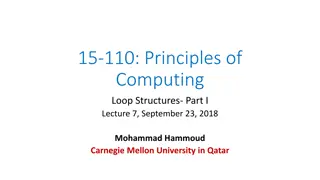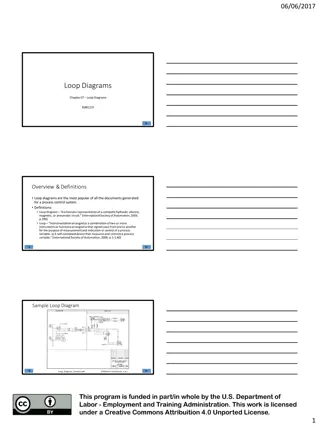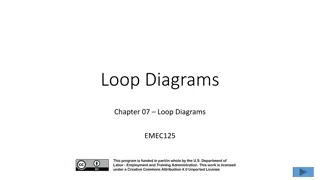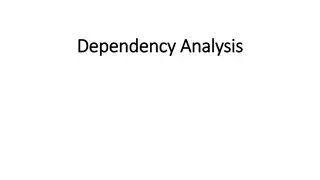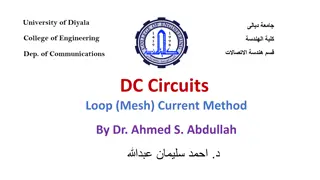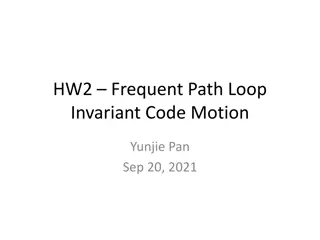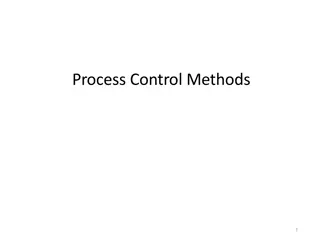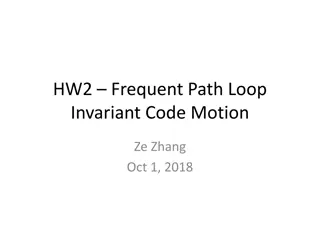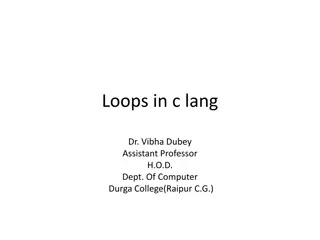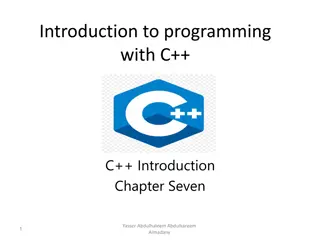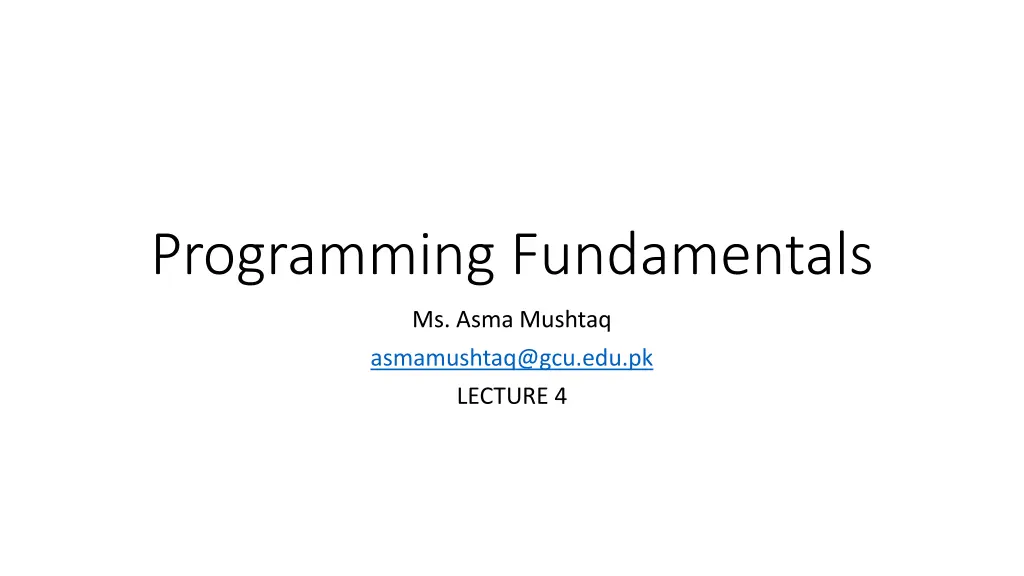
Programming Fundamentals with Ms. Asma Mushtaq Lecture Notes
Explore the basics of programming with Ms. Asma Mushtaq in Lecture 4 covering topics like the goto statement in C++, generating a table of multiples, and constructing a pyramid using for loops. Understand the concepts and implementations with examples and solutions provided.
Download Presentation

Please find below an Image/Link to download the presentation.
The content on the website is provided AS IS for your information and personal use only. It may not be sold, licensed, or shared on other websites without obtaining consent from the author. If you encounter any issues during the download, it is possible that the publisher has removed the file from their server.
You are allowed to download the files provided on this website for personal or commercial use, subject to the condition that they are used lawfully. All files are the property of their respective owners.
The content on the website is provided AS IS for your information and personal use only. It may not be sold, licensed, or shared on other websites without obtaining consent from the author.
E N D
Presentation Transcript
Programming Fundamentals Ms. Asma Mushtaq asmamushtaq@gcu.edu.pk LECTURE 4
Goto Statement The goto statement in C++ is a control flow statement that allows you to jump to a specific labeled statement within the same function. It is generally discouraged in modern programming because it can make code harder to read, maintain, and debug. However, it can be useful in certain situations, such as breaking out of deeply nested loops or handling errors.
Example #include <iostream> using namespace std; int main() { int age; cin>>age; if (age < 18) { goto notAdult; // Jump to the 'notAdult' label } cout << "You are an adult." << endl; goto end; // Jump to the 'end' label notAdult: cout << "You are not an adult." <<endl; end: return 0; }
Problem Statement Assume that you want to generate a table of multiples of any given number. Write a program that allows the user to enter the number and then generates the table, formatting it into 10 columns and 20 lines. Interaction with the program should look like this (only the first three lines are shown): Enter a number: 7 7 14 21 28 35 42 49 56 63 70 77 84 91 98 105 112 119 126 133 140 147 154 161 168 175 182 189 196 203 210
Solution int main() { int num; cout << "Enter a number: "; cin >> num; // Generate and print the table with 10 columns and 20 lines for (int i = 1; i <= 200; i++) { // 10 columns * 20 rows = 200 values cout << num * i << "\t"; // Print the multiple with a tab space if (i % 10 == 0) { // Move to the next line after every 10 numbers cout << endl; } } return 0; }
Problem Statement Use for loops to construct a program that displays a pyramid of Xs on the screen. The pyramid should look like this
Solution int main() { int rows = 5; // Number of rows in the pyramid for (int i = 1; i <= rows; i++) { // Loop for rows // Print spaces for alignment for (int j = 1; j <= rows - i; j++) { cout << " "; } // Print Xs in increasing odd numbers for (int j = 1; j <= (2 * i - 1); j++) { cout << "X"; } cout << endl; // Move to the next line } return 0; }
Nested Loops in C++ #include <iostream> using namespace std; int main() { for (int i = 1; i <= 5; i++) { // Outer loop for rows for (int j = 1; j <= 5; j++) { // Inner loop for columns cout << i * j << "\t"; } cout << endl; } return 0; }
#include <iostream> using namespace std; int main() { for (int i = 1; i <= 5; i++) { for (int j = 1; j <= i; j++) { cout << "*"; } cout << endl; } return 0; }
Practice Problems Write a program to separate the digits of an integer in the correct order. E.g., if Number=126548 then it should first print 1 then 2 then 6 and so on Write a program that prints a hollow square of n n taking n as input from user. Write a program that repeatedly asks the user to enter two money amounts expressed in old-style British currency: pounds, shillings, and pence. The program should then add the two amounts and display the answer, again in pounds, shillings, and pence. Use a do loop that asks the user whether the program should be terminated. Typical interaction might be Enter first amount: 5.10.6 Enter second amount: 3.2.6 Total is 8.13.0 Do you wish to continue (y/n)? To add the two amounts, you ll need to carry 1 shilling when the pence value is greater than 11, and carry 1 pound when there are more than 19 shillings.
Problem Write a program that calculates how much money you ll end up with if you invest an amount of money at a fixed interest rate, compounded yearly. Have the user furnish the initial amount, the number of years, and the yearly interest rate in percent. Some interaction with the program might look like this: Enter initial amount: 3000 Enter number of years: 10 Enter interest rate (percent per year): 5.5 At the end of 10 years, you will have 5124.43 dollars. At the end of the first year you have 3000 + (3000 * 0.055), which is 3165. At the end of the second year you have 3165 + (3165 * 0.055), which is 3339.08. Do this as many times as there are years. A for loop makes the calculation easy.
If-else statements in C++ The if-else statement in C++ is used for decision-making. It allows the program to execute a block of code only if a certain condition is true. if (condition) { // Code to execute if the condition is true } else { // Code to execute if the condition is false }
Problems To check either the number is positive or negative? To check either the number is even or odd? To check the number is prime or not? To check the number is perfect or not?
int main() { int num, flag = 1; cout << "Enter a number: "; cin >> num; if (num < 2) { flag = 0; } else { for (int i = 2; i < num; i++) { if (num % i == 0) { flag = 0; break; } } } if (flag == 1) cout << num << " is a prime number."; else cout << num << " is not a prime number."; }


